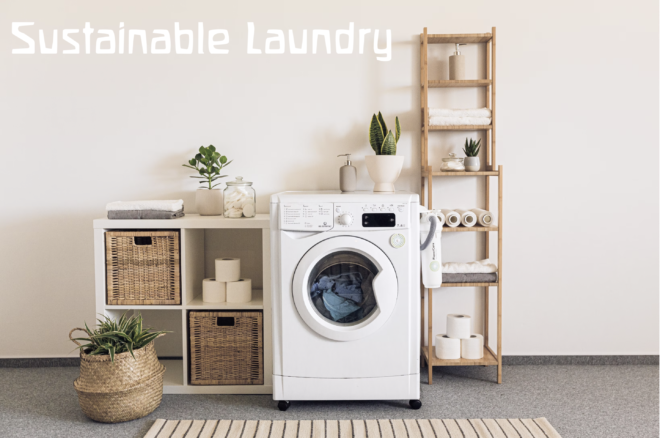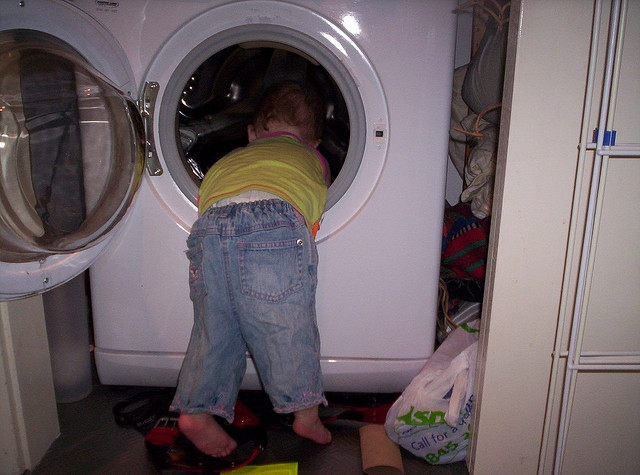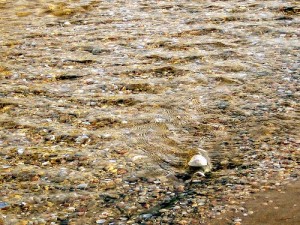Some of us are already using air conditioner water in our homes. Saving water may not be critical in Canada, but it is in the Middle East. Saving water to save money and energy is not only a personal financial consideration, but a global issue, as natural resources belong to all of us.
Today I want to talk about water savings in washing machines. You can jump to the best water saving tips here.
Some older washing machines, you might not know, have an option of using half the amount of water, saving near 10 gallons or 30 liters of water a load. As an added bonus, clothes come out cleaner.
How do clothes get cleaner when using less water? It turns out that filling the drum of the machine is unnecessary. As long as the clothes are wet, the agitation does the job, and better. Loose water only gets in the way, and also creates a need for more detergent.
What’s more energy efficient, top or front loader washing machine?
The current water crisis around the globe makes this a good time to revisit the long-time debate of American immigrants to the Middle East over whether a top-loading Maytag with the door on top is preferable to a European front-loader.
The top-loader works by filling its large drum with water, and a central agitator spins to clean the clothes. Standard front-loaders don’t need an agitator, so more clothes can fit into the smaller drum. The clothes agitate as the drum in a front-loading machine moves back and forth, capitalizing on gravity.
Seven years ago, my then 15-year-old Maytag gave out a few days before Rosh Hashanah (The Jewish New Year), and I bought an Electra for a price comparable to a new Maytag motor. I’ve had only minor repairs so far, but it’s largely a matter of chance. They are supposed to last about five years.
Are the advantages of top-loaders worth the excess water and energy use?
Below I list the main reasons to use a top-loading American machine, typically a Maytag.
- Maytags last longer. That may be true, but they are much more expensive. Parts and repairs also cost more. Of course, your smaller European machine will end up in a landfill faster.
- More clothes can fit into the top-loader. I did not notice a big difference, because the Maytag’s agitator is large and requires clothes to be stacked loosely. A huge amount can fit in a standard front loader, especially when using a regular cycle.
- The Maytag cycle is faster. This is true, and the switch to a front-loader requires a readjustment. But with planning you don’t need to sit and wait for laundry to finish—you can do other things. And the front-loader squeezes out more water so clothes dry faster, whether on the line or in a dryer. The length of the cycle also depends on whether you heat the water (see next point).
- Top-loading Maytags are connected to both hot and cold water faucets, allowing you to save money and energy on sunny days if you have a solar water heater. However, detergents today are designed to work well with cold water. Using cold water also shortens the cycle of the front-loader significantly, and extends the life of the machine. Front-loading machines attach to the cold water faucet and heat water according to the cycle chosen.
- Top-loaders are easier on the back, but a front-loader can be placed on a pedestal.
There are several major disadvantages to the Maytag:
- They don’t clean as well (but may put less stress on clothes for the same reason).
- They are too large for many Middle Eastern apartments, and may require being taken apart to fit through doors. They also require two faucets, not standard in Israeli laundry areas.
- They use twice as much water, more detergent, and more electricity (factoring out the heating of the water)
- Repairs and parts are expensive.
- Newer model front-loaders automatically adjust the water level, based on the amount of clothes.

Money and energy-saving laundry tips:
- Don’t wash it it if it’s not dirty. Use smocks and aprons to protect clothes.
- Always fill up the machine. Fill a front loader to the top, turning the drum to make more room. With a regular cycle (lower numbers) the machine can really be stuffed, as long as closing it doesn’t put stress on the door. Be gentle with the door as the hinges are a weak point, as are the knobs.
- Have enough clothes. If you are always doing a load because you run out of socks, buy more socks (or work out a system to keep them organized). You should have enough clothes to have something to wear when you are washing, plus something extra in case of emergency.
- Don’t have too many clothes. They tend to fall on the floor and require rewashing, and it’s harder to find what you need.
- Give family members their own distinctive towels. They are more likely to reuse them.
- When visiting friends offer to bring your own sheets, or a sleeping bag. Take the sheets you just took off the bed for changing.
- “Grey water” from the bath can be reused for laundry. Keep a couple of buckets in the shower and pour the used water into the machine through the opening for detergent while the water is running. I’ve noticed that my machine adds water to the first cycle in intervals. I add water until the water stops running, and try to be around for the second addition of water as well.
- Use a minimum of detergent. If your laundry smells like detergent after washing, you’re probably using too much. The extra soap also clogs up your machine.
- Hang laundry to dry.
What tips can you share for more efficient laundering?





Washing machine consume the less water but to use as low as possible is good and your tips gone help.
http://www.wholesalejerseysmallchina.com/
clothes last years and years and years longer when not tortured by an agitator!
belis–it just depends. Mine has lasted nearly ten years, but my technician says it’s on its last legs and my next one is likely to be of much poorer quality.
Why? Frontloaders end up at the dump faster? I know these machines last 15 to 20 years with intensive use (families with growing kids), they are way more economic and ecofriendly and… clothes last years and years and years longer when not tortured by an agitator!
Just my experience..
Bravo, Bros! keep going like this, more good info again.
Good!I want to try this at home and perhaps ask our cleaner to have this option, since it’ll save water and energy…Thanks!
with the new regulations going through as of july 1, 2009,
our household can use 30 cu.m wter for 2 months. more than that, we will be charged at a different and higher rate.
can you please tell me, approximately how much cu.m does a
AEG Lavomat 538 use for a wash ?
Thanks very much…
Brenda Alony
The new horizontal washing machines offer a BIG advantage to being able to air dry your clothes because they have faster spin-out speeds and those faster speeds mean your clothes are very well wrung out when you take them out of the washer.
Here is the coolest clothes drying rack I have found. It folds up really small. Since the top rotates it can be near a traffic path in your house and if you get close enough to brush into it just spins like a turnstile. Putting it right below the ceiling fan works nice on rainy days.